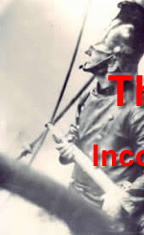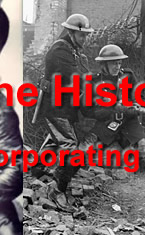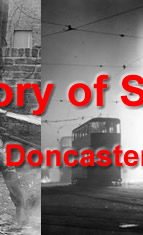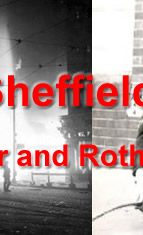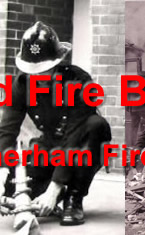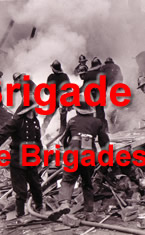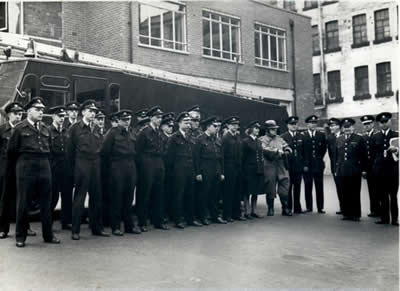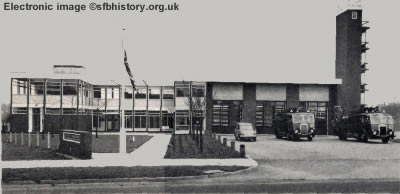
47 year-old Benjamin Jones was appointed Chief fire Officer on the 1st October, 1953. He had joined the City and County of Kingston-upon-Hull Fire Brigade in October, 1927, and sometime during the life of the National Fire Service he was transferred to Leeds as a Divisional Officer.
Benjamin was born 7th September 1906, at Cwm Penmachno, Caernarvonshire, Wales. He was the son of William Jones a Slate Quarry Rockman, and Elizabeth Ann Jones. In 1930 he married Irene T. Conyers at Sculcoates, East Yorkshire. In the 1939 census he was registered as being employed as a Police Firemen in the Kingston upon Hull Fire Brigade.
As a Kingston upon Hull Fireman he would have served the German air raids of the Hull Blitz, 7th to 9th May 1941, when the Luftwaffe changed their bombing tactics in an attempt to destroy Britain's shipping ports. The Hull Blitz killed approximately 400 people in the city, with 95% of Hull's houses left damaged. More than 300 men, women and children were buried in unmarked mass graves in Hull's Northern Cemetery.
Building Programme - Continuation
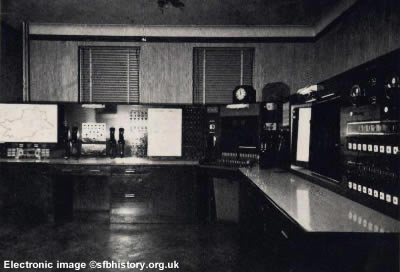 Photograph from: Sheffield Fire Brigade - A Brief History |
CFO Jones continued the Post-War building programme. The ethos of this programme was driven by the knowledge gained in the 1939 - 1945 period, and the uniqueness of the Sheffield terrain. Ultimately, when this work was finished Sheffield would have three fire stations serving the valley floor, covering both the industrial and business centres, and a fire station at the top of each hill covering the suburban residential areas. This plan gave a quick response to all incidents, insomuch, that all appliances could reach the city centre and industrial areas quickly, whereas, the valley floor appliances did not have to climb the steep hills out of the centre, as all the peripheral hill-top stations could cover these areas easily. Opposite: The updated watch room/fire control at Division Street, 1953. |
Queen's Long Service and Good Conduct Medal
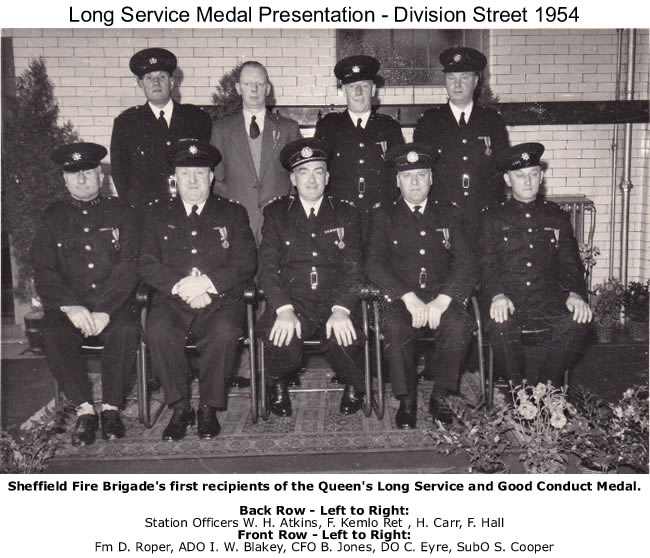 Photograph courtesy of Peter Walker |
The Queen’s institution of the medal marked her appreciation of long and meritorious service. The Secretary of State makes the awards which are subject to conditions of service and efficiency, the qualifying period being 20 years.
AFS Fleet Updated
Around 1955 the Austin K2's of the Auxiliary Fire Service were replaced 'nationwide' with the Bedford Emergency Pump equipped with a 1000 gpm 'Sigmund' centrifugal pump, the appliance which became affectionately known as the "Green Goddess". The AFS appliance fleet was complemented in the early 1960's by the addition of 4x4 Command/Off Road vehicles.
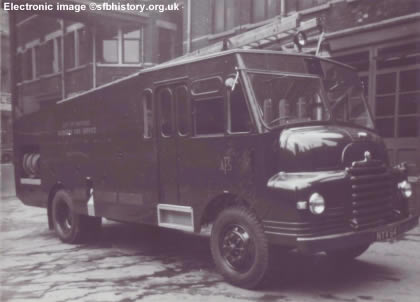 Green Goddess - Photographs courtesy of Ken Mettam |
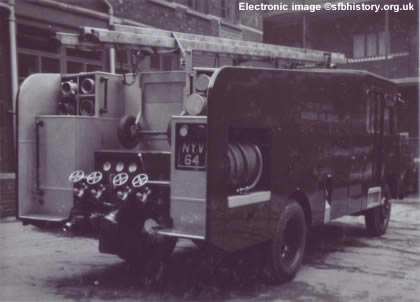 |
This replacement was mainly driven by the fact the demand of another war would require a different and much larger fleet of firefighting vehicles. The Bedford chassis was chosen because it was the base for the new army trucks being introduced around that time. Some ten body building firms added the firefighting bodies to the chassis. To view the inventory of the 'Green Goddess' appliance >>click here.
New Fire Station at Darnall
By 1956 the new Fire Station at Darnall Road was completed and was formally opened by the then Home Secretary, and by 1957 alterations were carried out to Fire Station No. 5. Elm Lane to bring it more up to date.
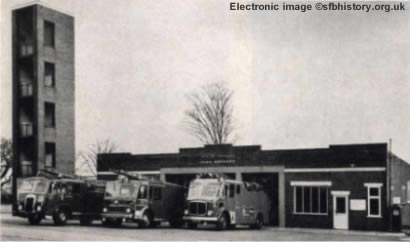 Elm Lane - Contemporary Photograph - Late 1960's From the Book 'Sheffield Fire Brigade - A Brief History' |
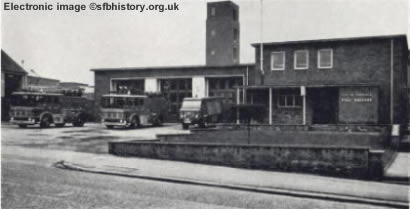 Darnall Road - Contemporary Photograph - Late 1960's From the Book 'Sheffield Fire Brigade - A Brief History' |
The old flats at the rear of the Central Fire Station, Division Street, were demolished. A block of garages for the Auxiliary Fire Service was erected on part of the land that had thus become available.
Photographs courtesy of John Hague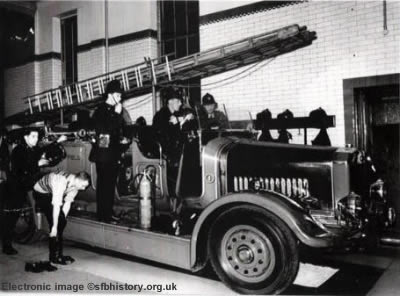 |
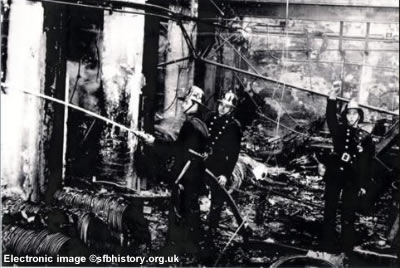 |
| Turnout from Division Street Fire Station in one of the last open cab appliances, circa 1957. The Leyland appliance (AWE 1) pictured was sold to Gipton Training School in 1958 |
Crew in action at Kaysor Ellinsons, Carlisle Street. (Left to Right: John Hague; Jimmy Green; Bill Varley) |
Sheffield's CFO Awarded O.B.E
CFO Benjamin Jones was awarded the OBE in the New Year Honours List of 1962.
The Sheffield Gale - 16th February 1962
In the early hours of the 16th February, 1962 wind speeds which started at 35 mph were recorded as having increased 75-80 mph were recorded at 4.00 am, and by 6.00 am had increased to recorded gusts of 96 mph.
By 8.00 am the city looked as though it had been struck by another blitz. 100 homes were beyond repair with a further 6,000 being no longer weatherproof. 100,000 were damaged to a lesser extent, and 250 people were made homeless. Overall it was estimated that two thirds of all houses in the city had suffered some form of damage.
Three people were killed as a direct result of the storm, and the was declared a disaster area by the national government, however, the repairs and costs associated with the gale fell very much with the city.
The ‘post war’ prefabricated dwellings suffered the ' worst. A whole row on the Arbourthorne estate was razed to the ground. Thirteen were uninhabitable.
The people who died were all victims of chimney falls:
John William Johnson, aged 17, of Colwell Street, Attercliffe, was trapped in his bed. Rescuers, including his father, a neighbour, and two police officers, were themselves trapped when the bedroom floor collapsed and plunged them into the room below.
Mrs. Shirley Hill, aged 30, wife of the vicar of Brightside, the Rev, Colin Hill. was sitting in a chair downstairs when the chimney-stack crashed through the roof and bedroom floor on to her.
Mrs. Ida Stabbs, aged 57, who died in hospital after a chimney fell on to her bed in Crookes, Sheffield. Her husband, Eric, aged 56, was taken to hospital in a serious condition.
Whole streets were blocked with rubble, slate, glass and loose masonry. Many roads were blocked by fallen trees. Part of Church Street in the centre was closed to traffic because of the danger of falling coping stones.
The Sheffield City Fire Brigade dealt with 1,000 calls, and still had to deal with a waiting list of another 1,000. Civil Defence Corps answered an urgent request for assistance from the fire brigade, and an emergency rest centre near the city centre was set up. The City Engineer's Department had 800 men and 80 lorries at work.
Sheffield City Fire Brigade, the Civil Defence Corps, the City Engineer's Dangerous Structures Department, and the Army dealt with 2,200 dangerous buildings.
Sheffield's Auxiliary Fire Service
The Auxiliary Fire Service was re-organised again during 1962 in order to secure in peace-time sufficient numbers of active and highly trained auxiliaries to help the regular fire service in time of war. The Sheffield contingent was extremely enthusiastic and was considered one of the best in the country.
Sheffield Auxiliary Fire Service roll call before leaving on a convoy exercise.
|
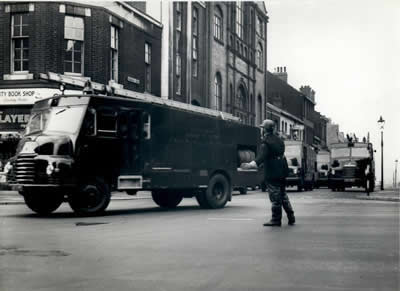 Photos from the Albert Reaney Collection |
Mansfield Road Fire Station
In 1963, the new Fire Station at Mansfield Road, which replaced the wartime stations on Woodhouse Road and Norton Lane was completed. At the time The Lord Mayor Alderman R. Neil said there was no better fire brigade in the country. It had the latest fire-fighting appliances and when Mr. Jones saw anything better the committee allowed him to have it because it was economy to have the best. Alderman C. W. Gascoigne leader of the City Council, said men who had such a hazardous job as firemen deserved the best conditions, and as far as he was concerned no economy would be exercised at the expense of the fire brigade. The Council had a choice of two sites. Either they could build on land in Mansfield Road from which an unsightly spoil heap had been removed, or at the Ridgeway/Hurl field Road junction. They eventually chose the Mansfield Road Site. |
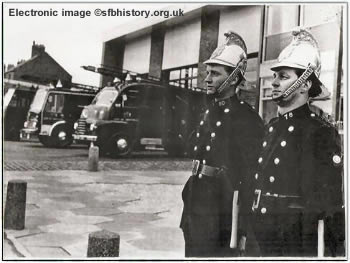 Photograph of the opening of Mansfield Road Fire Station Fm John Hague, and Fm Jeff Hollingworth in ceremonial dress Courtesy of John Hague |
September 1963
A brand new fire-engine-red wireless control car delivered to brigade headquarters at Division Street today is fitted with a two-tone horn warning instead of a bell. If the horn receives approval from the Home Office and is standardised, it could replace the bell warning used at present.
Breathing Apparatus
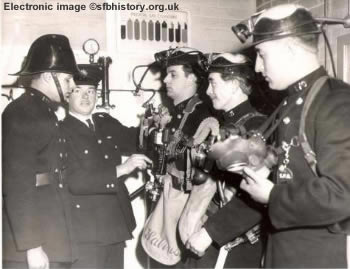 Photograph courtesy of John Hague |
Photograph taken in the BA Room at Division Street Fire Station August 1964 The (right-hand side back two Firemen are wearing half-hour 'Salvus' Oxygen re-breathing sets, which were in use at the time. Whereas, the Fireman in the foreground is wearing a prototype half-hour compressed air set which would become the standard issue breathing apparatus set. Please note the use of miners helmets in conjunction with miners lamps. This system of work enabled BA wearers to illuminate an area whilst keeping both hands free. >>View downloadable brief history of breathing apparatus
|
Self-Contained Oxygen Breathing Apparatus - Was still in use at this at this time. This apparatus was a development of that used in the mines and was of self-contained closed circuit type A cylinder of oxygen was carried sufficient for a duration of up to 1 hour The exhaled breath was returned to a breathing bag containing and absorbent which removed the carbon dioxide; it was then mixed with a fresh supply of oxygen and used again. The wearer inhaled and exhaled through breathing tubes fitted with non-return valves and connected to a mouthpiece. Goggles were worn for protection of the eyes. In the closed circuit types of oxygen breathing apparatus no outside air is taken into the set, nor is the exhaled breath discharged to atmosphere. The exhaled breath is regenerated by removal of the CO, and the substitution of fresh oxygen, and the amount of oxygen to be carried is only that actually consumed by the wearer, so that the cylinder into which the oxygen is compressed (usually at a pressure of 120 or 132 atmospheres (bar) is comparatively small. Whilst this apparatus was worn the fire helmet was dispensed with, and a miners helmet capable of carrying an 'Oldham' cap lamp was used. |
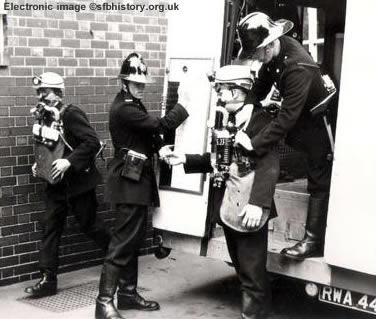 Photograph courtesy of John Hague BA Wearers using 'Proto' and 'Salvus' closed circuit oxygen breathing apparatus sets undergoing routine training. |
HMI Inspection
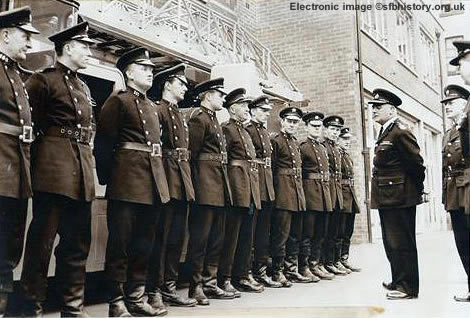 Photograph courtesy of John Hague |
Her Majesty's Fire Service Inspector Norwood inspecting Blue Watch, Division Street Fire Station, 12th August 1964 Blue Watch Left to Right: Officers: |
Lowedges Road Fire Station
Another new station to cover the expanding housing estate at Lowedges, was built on Lowedges Road and opened in 1965.
It is worth noting that as each fire station was built, it was equipped with an air raid siren, and a nuclear attack early warning console. This equipment stayed in situ until the early 1990's.
By 1966 the Brigade building programme was nearing completion. Appliances also began to be replaced. Throughout the late 1950's and early 1960's, the utilitarian appliances of the NFS were slowly phased out.
|
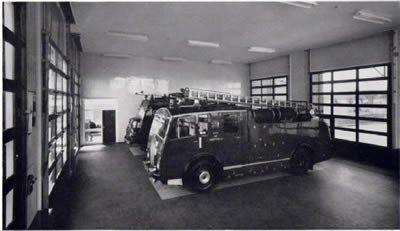 |
Pumping Appliances
Learning from their experience in the Blitz. All new Sheffield Appliances were fitted with 1000 gpm centrifugal pumps, and uprated engines and gearboxes to deal with the steep terrain.
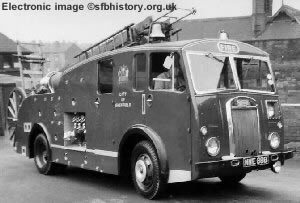 Dennis Escape/Pumping Appliance |
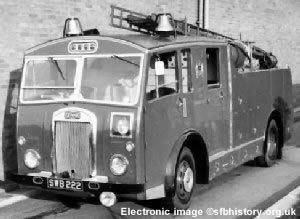 Dennis Ladder/Pumping Appliance |
During this time the duties placed upon the Fire Prevention Department by legislation had increased considerably, and the strength of the Department had frequently to be increased.
Unfortunately Mr. Jones, who had been unwell in the previous year, died on the 11th January, 1966.
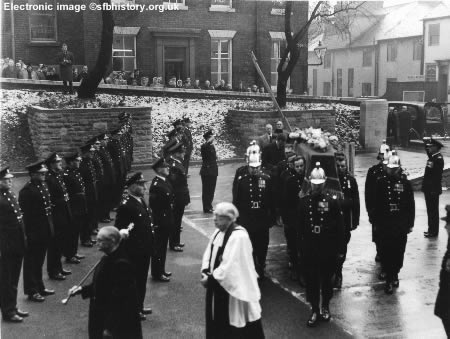 The funeral of CFO Ben Jones - Photograph courtesy of John Hague |
The Funeral of CFO Ben Jones Please Note: At this time brass helmets were only worn for ceremonial purposes. |
